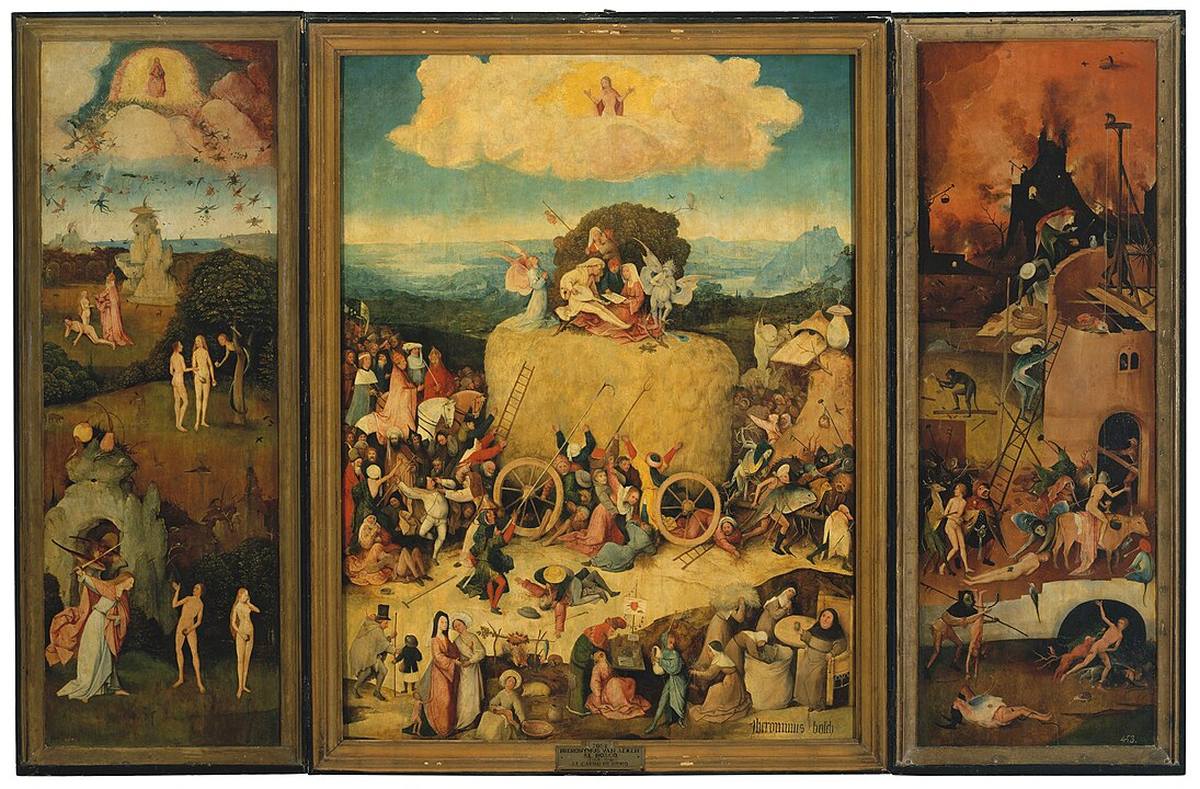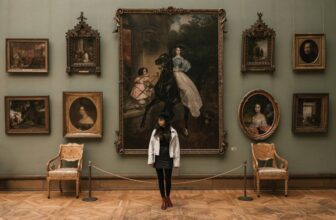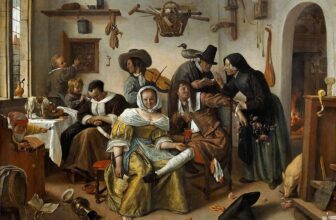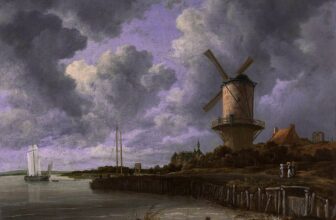
“When disease sneezes, Floods dances, and Calamity yawns, Don’t bother washing your hands – Just carry an umbrella and a cough drop.”
Meaning of The Haywain Triptych Painting
Few works of art in Western history carry the same combination of dazzling imagination, grotesque beauty, and moral warning as Hieronymus Bosch’s The Haywain Triptych. Painted around 1516, this monumental altarpiece is as much a mystery today as it was five centuries ago. To stand before it is to be overwhelmed by a vision of humanity caught between sin and salvation, a moral landscape full of demons, angels, peasants, nobles, and otherworldly creatures.
In this exploration, we’ll look at who painted The Haywain Triptych, how it was created, what it represents, the symbolism woven into its panels, the controversies it stirred, and why it continues to fascinate. By the end, you’ll have a sense of why this late-medieval masterpiece remains one of the most haunting mirrors ever held up to human society.
Who Painted The Haywain Triptych?
The man behind the triptych was Hieronymus Bosch (c.1450–1516), a painter from the town of ’s-Hertogenbosch in the Duchy of Brabant (now the Netherlands). Bosch’s real name was Jheronimus van Aken, but he adopted the name of his hometown, branding himself as Bosch.
Bosch belonged to a well-known family of painters. His grandfather, father, and uncles were all artists, and he grew up immersed in the world of pigments, brushes, and panel construction. Unlike many of his contemporaries, Bosch did not travel to Italy or absorb the humanist Renaissance style firsthand. Instead, he developed a highly distinctive visual language rooted in Netherlandish Gothic traditions but pushed into the realm of dreams, nightmares, and moral allegory.
His works were celebrated by his contemporaries for their originality. Wealthy patrons, including the House of Nassau and even King Philip II of Spain, collected Bosch’s art. The Haywain Triptych was one of the pieces eventually purchased by Philip II, who placed it in his private chambers at the Escorial monastery-palace near Madrid.
How Was The Haywain Triptych Painted?
Bosch painted the triptych on wooden panels, most likely oak, as was typical for Netherlandish altarpieces of the 15th and 16th centuries. The triptych format consists of three panels joined together with hinges, allowing the side wings to fold over the central scene.
The painting technique followed the Northern European tradition: a gesso ground was laid over the wooden surface, then underdrawings were made in thin black lines to sketch the composition. Over this, Bosch layered thin glazes of oil paint, building up the vibrant, luminous colors and eerie, glowing effects for which he is renowned.
What sets Bosch apart is not simply technical skill but his astonishing inventiveness. Unlike the serene religious art of his Italian contemporaries, Bosch filled his panels with swarming figures, tiny scenes of chaos, strange hybrid monsters, and bizarrely comic details. His brush created a world at once familiar and alien, where the ordinary and the fantastic collide.
What Is The Haywain Triptych All About?
At its heart, The Haywain Triptych is a moral allegory about human greed, folly, and the fleeting nature of worldly pleasures. It presents a panoramic vision of humanity caught in the struggle between divine salvation and damnation.
When closed, the outer wings show a gray-toned scene of a pilgrim journeying through a hostile world full of temptations and dangers. When opened, the three inner panels tell the story in stages:
Left Panel – Paradise and the Fall of Humanity
The left wing depicts the Garden of Eden. At the top, God the Father presides over the creation of Eve. Below, Adam and Eve fall into sin through the temptation of the serpent. Further down, they are expelled from Paradise by an angel wielding a sword. Already, the seeds of human corruption are planted.Central Panel – The Haywain
The central image is the great “haywain”, a colossal wagon loaded high with hay, dragged across the earth by demons. On and around it, humans from all walks of life, peasants, clerics, nobles, even kings, scramble desperately to snatch a handful of hay. The symbolism is clear: hay represents earthly goods, pleasures, and wealth, all of which are insubstantial, fleeting, and ultimately meaningless. At the very top of the hay, a few figures indulge in music and merrymaking, oblivious to their fate. Christ appears in the sky above, looking down with sadness, but humanity ignores him.Right Panel – Hell and Damnation
The right wing shows the consequences: Hell. Fires rage, demons torture souls, grotesque structures loom in the darkness. Humans who pursued greed and pleasure without thought of salvation now face eternal punishment.
Taken together, the panels form a journey: from innocence (Paradise), through corruption (the Haywain), to consequence (Hell).
Symbolism and Meaning of The Haywain Triptych
Bosch’s symbolism is multilayered and complex, but some key meanings emerge:
The Hay (Central Symbol): In medieval culture, hay was a metaphor for vanity, worthlessness, and the transience of material wealth. As hay withers quickly and is blown away by the wind, so too are earthly goods fleeting. The haywain at the center embodies this moral truth: all of humanity is chasing after what cannot last.
Demons Dragging the Wagon: The wagon is pulled not by horses but by grotesque devils. This indicates that human greed is literally driven by infernal forces.
Diversity of Figures: From peasants to nobles to clergy, all classes scramble for hay. Bosch emphasizes that corruption and greed are universal, sparing no group.
Christ Above: Though Christ watches from above, offering the possibility of salvation, no one looks upward. Humanity has turned entirely to earthly pursuits.
The Musical Group on Top of the Hay: Music, often associated with sensuality and distraction in Bosch’s time, represents indulgence in pleasure while ignoring eternal consequences.
The Fall of Man in the Left Panel: The roots of greed and folly lie in original sin, the disobedience of Adam and Eve.
The Pilgrim on the Outer Panels: When closed, the triptych reminds viewers of their own earthly journey. The pilgrim represents each individual soul, struggling against temptation, hoping to reach salvation.
What Is Happening in The Haywain Triptych?
The triptych is not a static picture but a moving narrative. Here’s what unfolds:
In the left wing, the story begins with creation and the fall. Humanity starts in divine grace but quickly succumbs to sin.
In the central panel, the haywain dominates the landscape. People of all ranks fight, cheat, and even kill to grab hay. The wagon is dragged steadily forward by demons, suggesting that society as a whole is moving toward damnation.
In the right wing, the tragic end arrives: Hell’s fires engulf those who wasted their lives chasing hay.
The entire sequence reflects a medieval moral worldview: life is a pilgrimage, choices have eternal consequences, and the majority of humanity risks damnation through greed and blindness.
What Type of Art Is The Haywain Triptych?
The work belongs to the tradition of Northern Renaissance religious art, but Bosch’s style is unique. It combines elements of:
Altarpiece Painting: Triptychs were commonly used in churches as devotional images.
Didactic Allegory: The triptych functions as a teaching tool, warning believers of the dangers of sin.
Fantastic Imagery: Bosch’s surreal creatures and nightmarish visions anticipate later movements such as surrealism.
Thus, the Haywain is not merely a devotional image but also a proto-modern exploration of the subconscious, long before Freud or Dalí.
Why Is The Haywain Triptych Controversial and a Mystery?
The controversy surrounding Bosch’s work stems from its strangeness. In an age when most religious art depicted serene Madonnas or clear Biblical scenes, Bosch filled his panels with grotesque hybrids, comic absurdities, and terrifying demons. Scholars have debated for centuries what his bizarre figures mean.
Moral Clarity vs. Ambiguity: Some see the Haywain as a straightforward moral lesson: avoid greed, seek salvation. Others argue the abundance of playful, humorous details undercuts the seriousness, leaving room for ambiguity. Was Bosch condemning, satirizing, or simply entertaining?
Symbolism Decoded or Lost? Medieval viewers may have understood symbols that we no longer grasp. For example, animals, tools, and costumes all carried associations that are partly lost to modern eyes.
Bosch’s Personal Beliefs: Was Bosch a devout Catholic warning against sin? Or a cynic mocking human folly? His true intent remains uncertain.
Because of these questions, Bosch is often seen as an enigma, both a moralist and an artist of the absurd, both medieval and startlingly modern.
Where Is The Haywain Triptych Today?
Today, the Haywain Triptych is housed in the Museo del Prado in Madrid, Spain. It arrived there because King Philip II, a devout Catholic and fervent admirer of Bosch, acquired the work in the 16th century and placed it in the Escorial monastery. In the 19th century, it was transferred to the Prado, where it remains one of the museum’s treasures.
Visitors can see it alongside Bosch’s other masterpieces, including The Garden of Earthly Delights and The Adoration of the Magi.
Why Does The Haywain Triptych Still Matter?
The triptych endures because it speaks to timeless human struggles. Bosch’s hay is not just a medieval symbol but a universal metaphor. In every age, people chase after wealth, status, pleasure, and material success, often forgetting deeper values.
The image of a world where everyone grabs at hay while ignoring Christ in the sky feels hauntingly modern. Bosch’s message, whether read as religious or broadly philosophical, is that humanity risks losing itself in distractions.
Hieronymus Bosch’s The Haywain Triptych is not just a painting but a vision, a moral tale, and a riddle. Painted in the early 16th century, it combines religious devotion, biting social critique, and surreal imagination. It shows humanity’s fall, its obsession with fleeting goods, and its ultimate damnation, yet leaves open the possibility of redemption.
Its controversy lies in its strangeness: is it a sermon in paint, or a carnival of absurdity? Its mystery lies in its detail: every creature, gesture, and symbol could hide meanings we have only partially recovered.
Today, in the Prado Museum, the triptych still draws viewers into its strange, teeming world. To stand before it is to confront a question Bosch posed five hundred years ago: Are we pilgrims seeking salvation, or are we clambering over one another for handfuls of hay?




